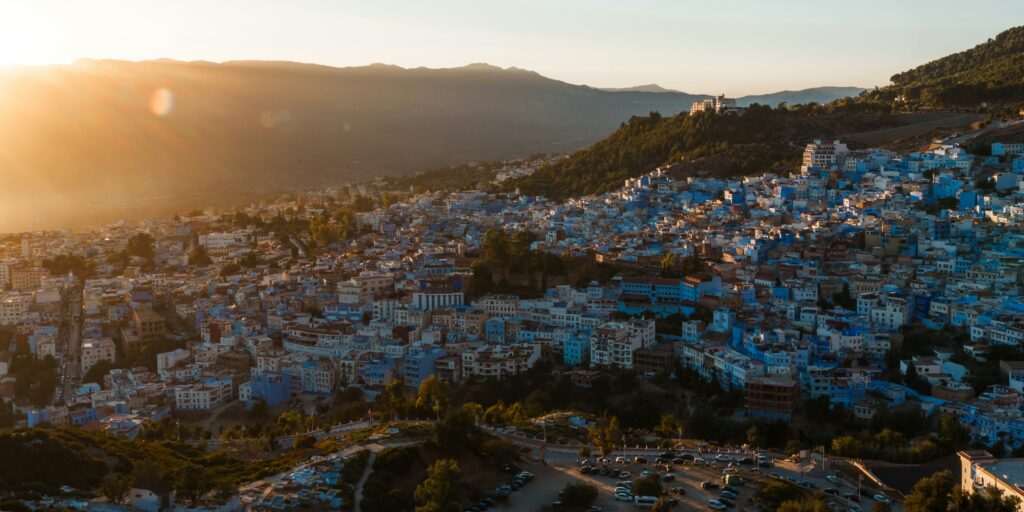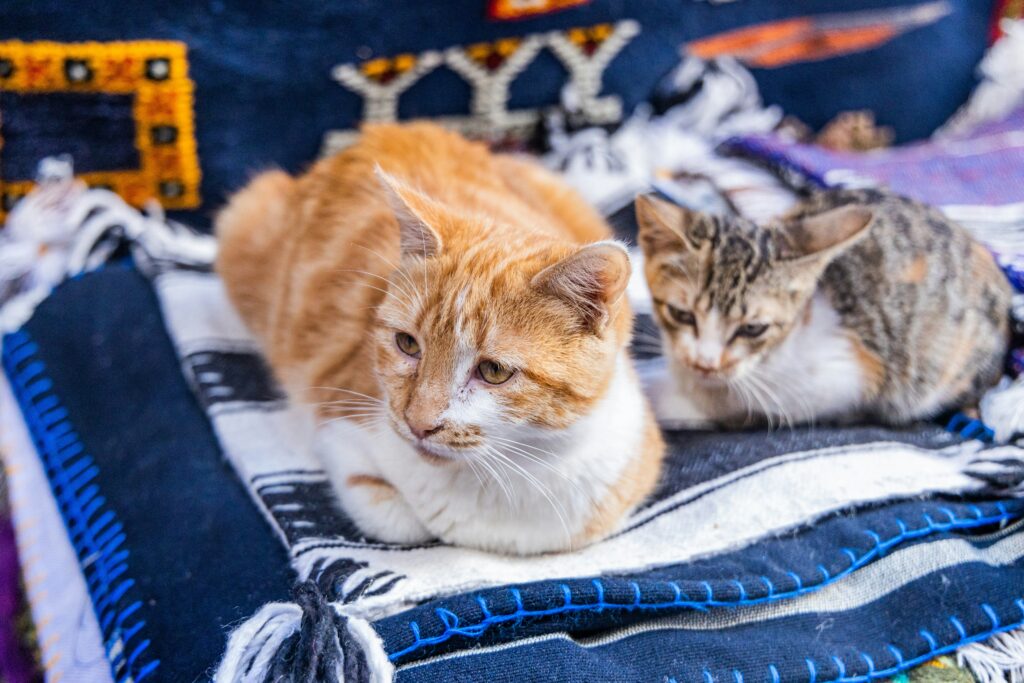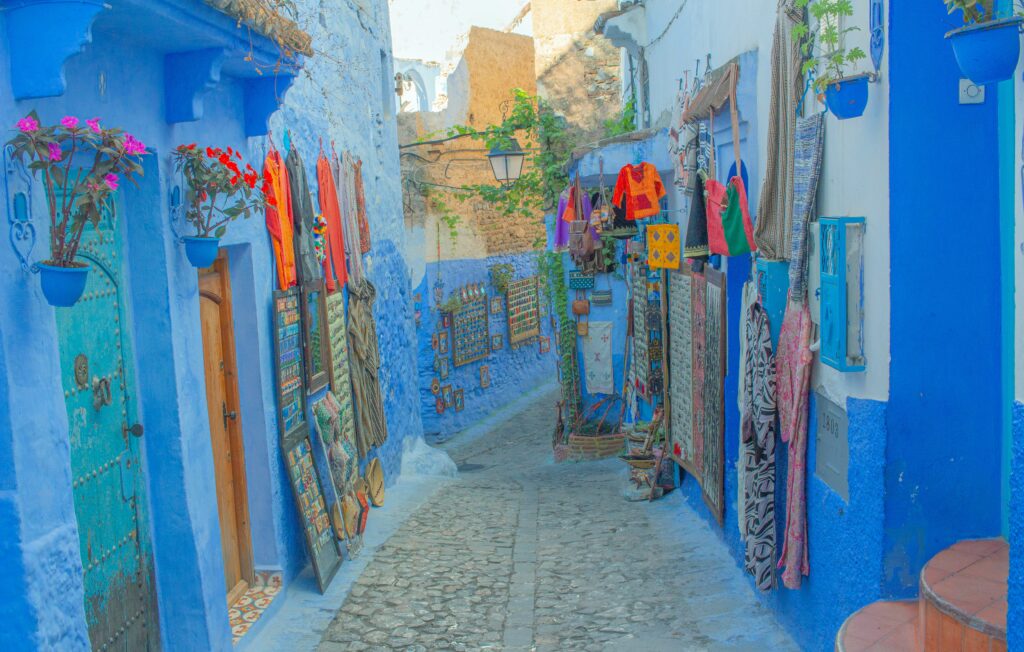
Introduction: Welcome to the Blue City
Tucked away in the Rif Mountains of northern Morocco, Chefchaouen is known for its peaceful atmosphere, breathtaking scenery, and of course its famous blue-painted walls. Nicknamed “The Blue Pearl”, this charming town is a must-see destination for travelers seeking authenticity, culture, and unforgettable photo opportunities.
Whether you’re a solo traveler, a couple, or a family, Chefchaouen offers something special for everyone.
Why Is Chefchaouen Blue?
One of the first things visitors ask is:
Why is Chefchaouen painted blue?
The answer is part mystery, part history and it makes Chefchaouen one of the most unique towns in the world.
Theories Behind the Blue Walls:
- Spiritual Symbolism
Many believe the blue was introduced by Jewish refugees in the 1930s, who painted the walls to reflect the sky and remind them of heaven and spirituality. - Mosquito Repellent
Locals often say the blue paint helps repel mosquitoes, as the color supposedly mimics flowing water something mosquitoes avoid. - Cooler Temperatures
The blue tones help keep homes cooler in the heat by reflecting sunlight, making it more comfortable in the hot summer months. - Tourism & Tradition
Over time, the blue color became part of the city’s identity and charm. Today, it’s preserved not only for tradition but also for its beauty and its popularity with photographers and tourists from around the world.

No matter the reason, the result is magical.
Walking through Chefchaouen feels like stepping into a calm, colorful dream. Every shade of blue tells a story one that makes this town unforgettable.
Top Things to Do in Chefchaouen
Chefchaouen may be small, but it’s packed with charm, culture, and unforgettable sights. Whether you’re a photographer, a foodie, or a traveler looking to slow down, here are the best things to do in Chefchaouen:
1. Get Lost in the Blue Medina
The old medina is the heart and soul of Chefchaouen. Wander through its maze of blue-painted alleyways, doors, and staircases. Every corner feels like a postcard, and the peaceful vibe makes it easy to explore without pressure.
Tip: Go early in the morning or late afternoon for the best lighting and fewer crowds.
2. Visit the Grand Mosque (Jama’a Kabir)
Located in the main square, this mosque is unique for its octagonal minaret, unlike any other in Morocco. While non-Muslims cannot enter, the outside is beautiful to photograph and admire.
3. Explore the Kasbah and Ethnographic Museum
Step into history at the Kasbah of Chefchaouen, a 15th-century fortress built by Moulay Ali Ben Rachid. Inside, you’ll find:
- A peaceful Andalusian-style garden
- An ethnographic museum with traditional clothing and artifacts
- A tower offering panoramic views of the medina
Entry fee: Around 10 MAD (~$1 USD)
4. Hike to the Spanish Mosque
Located on a hill overlooking the town, the Spanish Mosque offers the best viewpoint in Chefchaouen. It’s a short 20–30 minute hike, especially popular at sunset.

Don’t forget your camera golden hour here is stunning.
5. Shop for Unique Local Handicrafts
Chefchaouen is famous for handmade goods you won’t find elsewhere, like:
- Colorful woven blankets and rugs
- Woolen clothing
- Natural dyes and soaps
- Locally made leather and pottery
Prices are usually lower and more fair than in larger cities like Fes or Marrakech.
6. Try Traditional Northern Moroccan Cuisine
Chefchaouen has its own culinary style. Must-try dishes include:
- Bessara (creamy fava bean soup)
- Goat cheese from the Rif Mountains
- Tagine with dried fruit and nuts
- Freshly baked Moroccan bread served with olive oil and olives
For an authentic experience, eat at a family-run riad or local restaurant.
7. Relax in Plaza Uta el-Hammam
This is the central square of Chefchaouen, surrounded by cafés, restaurants, the kasbah, and the mosque. It’s the perfect spot to:
- Sit under the trees
- Sip a mint tea
- Watch the daily life go by

8. Take a Nature Walk in the Rif Mountains
Chefchaouen is surrounded by the Rif Mountains, offering easy access to nature and hiking trails. If you’re adventurous, consider:
- A half-day hike to waterfalls or small villages
- A full-day trip to Akchour Waterfalls, about 45 minutes away
Local guides are available and recommended for longer treks.
Bonus: Do Nothing
Yes sometimes, the best thing to do in Chefchaouen is nothing at all.
Let the blue city slow you down. Sit on a quiet stairway, enjoy the mountain breeze, and just take it all in.
Would You Like Help With?
- A custom map of all the top spots?
Where to Stay in Chefchaouen?
Best Areas
- Medina (Old Town) — Ideal if you want to be in the heart of everything: narrow blue lanes, cafés, shops, easy access to main sights. Walking-only streets in many parts.
- Upper Medina — Offers more peace, often slightly cooler air, with views over the town and surrounding mountains.
- Just outside the Medina — If you have a car or want parking, these options may be more convenient, sometimes quieter and more spacious.
Accommodation by Budget
| Budget Level | What To Expect | Example Places / Types |
|---|---|---|
| Ultra-Budget / Hostels | Shared dorms or basic private rooms, simple amenities, possibly shared bathrooms, very local + social vibe. Great for backpackers. | Hostels/dorms around 80‑150 MAD/night |
| Budget Guesthouses / Private Rooms | Private bathroom, small riads or family-run guesthouses inside or near the Medina, some with rooftop terrace. | Dar Scotlandee, Aline Hostel, Hotel Souika, Auberge Dardara. |
| Mid‑Range Riads / Hotels | Beautiful décor (Moroccan style), comfort, better amenities, nice bathrooms, rooftop terraces, possibly spa features. | Riad Nila, Riad Cherifa, Casa Perleta. |
| Luxury Riads / Boutique Hotels | High-end design, extras like indoor pools, spa / hammam, elevated views, more privacy, excellent service. Located often in or very near the Medina. | Lina Ryad & Spa is a top luxury choice. |
Highlighted Stays
Here are some specific riads / guesthouses that are highly rated:
- Lina Ryad & Spa — Luxury riad with spa, great views, excellent amenities.
- Dar Echchaouen Maison d’Hôtes & Riad — A peaceful riad with a strong reputation.
- Riad Nila — Stylish, centrally located, comfortable, rooftop terraces.
- Casa Perleta — Boutique, charming, good views, very atmospheric.
- Dar Ba Sidi & Spa — For those who want a bit more luxury plus spa features.
- Casa Hassan — Cozy, central, good value.
Pricing & Tips
- Average hotel price in Chefchaouen is about US$50‑60 (mid‑range).
- In low budget / hostels, dorm beds can be as low as 80‑150 MAD (~US$8‑15).
- Luxury / premium riads can cost significantly more, especially during peak seasons.
- Shoulder seasons (spring and fall) offer a good balance: cooler weather, fewer crowds, sometimes lower rates.
Wat to Eat in Chefchaouen?
Taste the flavors of Northern Morocco
Chefchaouen isn’t just a feast for the eyes it’s also a fantastic place to enjoy authentic Moroccan cuisine, often with local twists you won’t find elsewhere. Thanks to its Berber roots, Andalusian influences, and mountain setting, the food here is comforting, fresh, and full of flavor.
1. Bessara (Fava Bean Soup)
This hearty, creamy soup made from fava beans, olive oil, garlic, and spices is a local breakfast favorite especially on cooler mornings in the mountains.
Try it at a small local café with fresh khobz (Moroccan bread) and cumin sprinkled on top.
2. Fresh Goat Cheese
Chefchaouen is located in the Rif Mountains, where goats are raised in nearby villages. You’ll often find locally made, soft goat cheese served with olives and bread at breakfast.
Simple, fresh, and made daily don’t miss it if you love cheese.
3. Tagine with Local Ingredients
Tagine is a Moroccan classic, but in Chefchaouen, you’ll often find regional variations:
- Chicken tagine with preserved lemon and olives
- Beef or lamb tagine with prunes and almonds
- Vegetable tagines with fresh mountain produce
The lemon chicken tagine is a local specialty, often cooked with saffron and green olives.
4. Kefta (Grilled Meatballs)
Kefta is made from minced beef or lamb, spiced and grilled, then served with flatbread and fresh herbs. You may also find it in tagines, baked with eggs and tomato sauce.
5. Local Bread (Khobz)
Bread is a central part of Moroccan meals, and in Chefchaouen, many families bake their own in traditional clay ovens. You’ll find it served at nearly every meal, often warm and freshly made.
6. Pastilla (Sweet & Savory Pie)
Though more common in Fes, some restaurants in Chefchaouen serve this delicate pie made with phyllo dough, chicken or pigeon, almonds, cinnamon, and sugar. A delicious balance of savory and sweet.
7. Mint Tea (“Moroccan Whiskey”)
Every meal (and every conversation!) in Morocco includes fresh mint tea, often served with a lot of sugar and poured from high to create bubbles.
Many cafés in Chefchaouen also offer variations with mountain herbs like verbena or thyme.
8. Zaalouk & Taktouka (Moroccan Salads)
These are warm, cooked salads served as starters or sides:
- Zaalouk: smoky eggplant, tomato, garlic, olive oil
- Taktouka: green peppers and tomatoes with paprika and cumin
Where to Eat in Chefchaouen?
Here are a few recommended spots:
| Place | What It’s Known For |
|---|---|
| Bab Ssour | Authentic local dishes, budget-friendly, cozy vibe |
| Casa Hassan Restaurant | Beautiful décor, traditional meals, good service |
| Restaurant Aladdin | Rooftop views of the medina, popular with tourists |
| Assaada Restaurant | Great for tagines and fresh salads |
| Chez Hicham | Lovely riad restaurant with regional dishes and good ambiance |
Travel Tip:
Avoid very touristy menus with pizza and pasta you’ll get the best experience by choosing family-owned riads or cafés that cook with love and local ingredients.
How to Get to Chefchaouen?
- From Tangier: ~2.5 hours by car or shared taxi
- From Fez: ~4 hours by car
- There’s no train station, so travel is by bus, taxi, or private tour
Need help with transport or guided tours? Sahara trip Morocco offers door-to-door transfers and day trips to Chefchaouen from nearby cities.
Best Time to Visit Chefchaouen?
- Spring (March–May) and Fall (September–November) have ideal weather sunny, warm, and not too crowded.
- Summers are hot, especially in July and August.
- Winters are mild, but rain is more likely.
FAQ: Common Questions About Chefchaouen
Is Chefchaouen safe for tourists?
Yes, it’s one of the safest cities in Morocco, known for its calm and friendly vibe.
Can you visit Chefchaouen in a day?
Yes, but staying overnight allows you to enjoy the quiet early mornings and sunsets.
Is it worth visiting?
Absolutely it’s one of the most unique towns in Morocco and offers a very different experience from the big cities.
Don’t Forget Your Camera!
Chefchaouen is one of the most photographed cities in Morocco and for good reason. The lighting, the colors, and the peaceful energy make it unforgettable.
Final Thoughts: Is Chefchaouen Worth Visiting?
Yes 100%. Whether you’re a photographer, a culture lover, or simply someone looking to slow down and experience a different side of Morocco, Chefchaouen offers peace, beauty, and charm that’s hard to find anywhere else.
From the iconic blue medina to the mountain views, friendly locals, and rich cuisine this small town will leave a big impact on your journey.
Planning Your Trip?
If you’re looking for private tours, local drivers, or help planning your Chefchaouen itinerary, feel free to contact us we’re here to help you make your Morocco adventure stress-free and unforgettable.
Chefchaouen isn’t just a destination it’s a feeling. And once you’ve been, you’ll understand why travelers return again and again.




